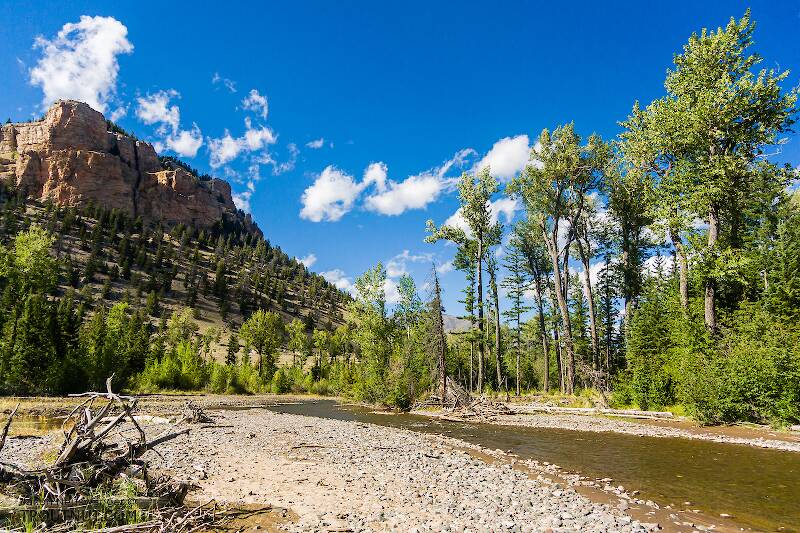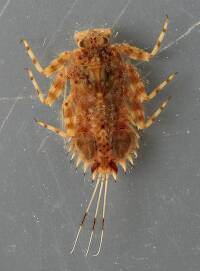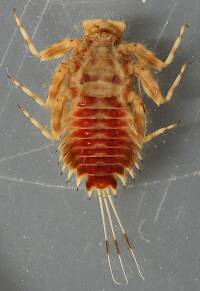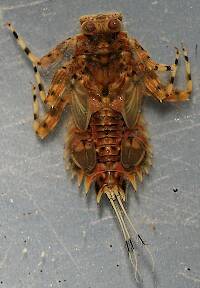
Salmonflies
Pteronarcys californica
The giant Salmonflies of the Western mountains are legendary for their proclivity to elicit consistent dry-fly action and ferocious strikes.
Featured on the forum

Nymphs of this species were fairly common in late-winter kick net samples from the upper Yakima River. Although I could not find a key to species of Zapada nymphs, a revision of the Nemouridae family by Baumann (1975) includes the following helpful sentence: "2 cervical gills on each side of midline, 1 arising inside and 1 outside of lateral cervical sclerites, usually single and elongate, sometimes constricted but with 3 or 4 branches arising beyond gill base in Zapada cinctipes." This specimen clearly has the branches and is within the range of that species.

Troutnut is a project started in 2003 by salmonid ecologist Jason "Troutnut" Neuswanger to help anglers and
fly tyers unabashedly embrace the entomological side of the sport. Learn more about Troutnut or
support the project for an enhanced experience here.
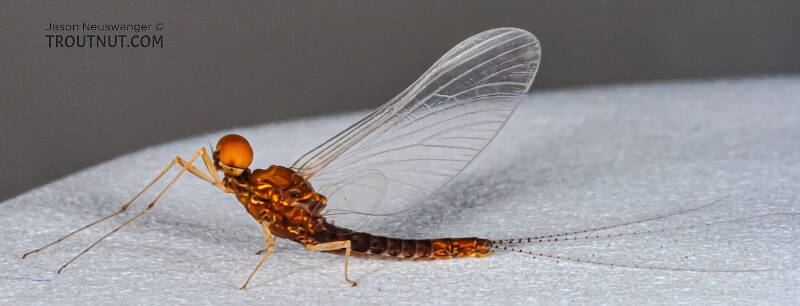
The genus ID on this specimen is confident but species is very tentative, based on the tentative ID of a seemingly-identical specimen from a nearby river a few days apart.
GONZO on May 24, 2009May 24th, 2009, 11:00 am EDT
This spinner is Eurylophella rather than E. invaria. The long 9th abdominal segment of Eurylophella is often the easiest way to avoid confusing the duns and spinners with Ephemerella. The claspers and genitalia of this male are also representative of Eurylophella.
Wiflyfisher on May 24, 2009May 24th, 2009, 3:05 pm EDT
Lloyd, what the heck is Eurylophella???
John S.
https://WiFlyFisher.com
https://WiFlyFisher.com
GONZO on May 24, 2009May 24th, 2009, 4:18 pm EDT
John,
Eurylophella species comprised the "bicolor" group of Ephemerella until Allen elevated subgenera (like Drunella, Serratella, Attenella, etc.) in 1980. Although widespread and fairly common, they are infrequently mentioned in fly-fishing literature. In streams and rivers, Eurylophella nymphs usually inhabit slow, weedy water, but some are also found in lakes. Most Eastern/Midwestern species seem to emerge sometime in June/July. The dark-winged duns can also be mistaken for other species, like Ephemerella needhami.
Eurylophella species comprised the "bicolor" group of Ephemerella until Allen elevated subgenera (like Drunella, Serratella, Attenella, etc.) in 1980. Although widespread and fairly common, they are infrequently mentioned in fly-fishing literature. In streams and rivers, Eurylophella nymphs usually inhabit slow, weedy water, but some are also found in lakes. Most Eastern/Midwestern species seem to emerge sometime in June/July. The dark-winged duns can also be mistaken for other species, like Ephemerella needhami.
Quick Reply
Related Discussions
Topic
Replies
Last Reply
Re: Best of the Forum--Most Useful and Informative Bug Threads Featured Topic
In General Discussion by Martinlf
In General Discussion by Martinlf
17
Feb 26, 2016
by Crepuscular
by Crepuscular
0
Jul 10, 2006
by Troutnut
by Troutnut
2
Sep 5, 2012
by Sayfu
by Sayfu
Re: hook size (and chocolate duns, and old-timey mayfly family classifications)
In Eurylophella Mayfly Nymph by Warren
In Eurylophella Mayfly Nymph by Warren
10
Apr 13, 2007
by Quillgordon
by Quillgordon

